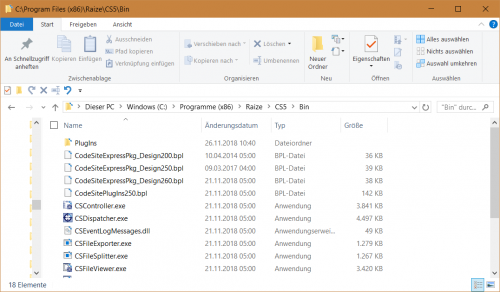-
Content Count
568 -
Joined
-
Last visited
-
Days Won
8
Posts posted by Markus Kinzler
-
-
But the number of bugs is alarming on the other hand.
-
-
ACID depends on used storage engine
-
The basics of the HighDPi support origines from @Uwe Raabe. But his silution wasn't implemented in full range.
https://www.delphipraxis.net/196643-high-dpi-patches-delphi-von-uwe-raabe.html
https://www.delphipraxis.net/1419242-post4.html
-
 2
2
-
-
If using UniDAC, IBX, ... it even run on remote servers.
-
37 minutes ago, Arnaud Bouchez said:@dummzeuch The feature matrix (page 18ff) states that FireDAC is not in CE - see "Windows/Mac enterprise database support, including MySQL, MariaDB, Microsoft SQL Server, Oracle Database, InterBase, PostgreSQL, Informix, Sybase SQL Anywhere, Microsoft Access, IBM DB2 Server, Firebird, Advantage Database, generic ODBC driver" is not checked, and also MongoDB, most/some WebBroker and DBExpress features, DataSnap and RadServer.
This features are missing in Pro, too. That was the fact Thomas wanted to tell you. You can access the DBMS locally but not on a "external" server (other than the machine the program is running).
-
Installed Rio 2 times. This error seems a issue.

-
13 minutes ago, Attila Kovacs said:You can't. A 14 years old research has shown that deleting / editing posts are better not allowed.
In this case it was just a double post. I removed it. @David Schwartz you can report a post and ask someone of the team to remove it.
I will remove this post tomorrow, too.
-
You need a control with a "virual" mode, loading data as needed. In your case you may have a look on VirtualTreeView.
-
The base ide ist part of the installer itself. Addition of platforms should be possible when problem of the download server(s) are solved.
-
QuoteWhichever DB you decide to use - don't expose the DB as remote storage for to your game clients, but use a REST interface or similar instead.
He does this already. But he uses a Textfile for storage.
-
Quoteturns SQLite into a real multi-user DBMS
Then multible users can access the db at the same time. But I wouldn't call this real muti user.
QuoteAdvises for using an ORM - only use ORM (Object-Relation Mapping) for the simple CRUD part, but don't map your entire data model into a ORM. Doing the latter is the root cause of all complains about ORM from all the Java, C# and Delphi programmers.
Especially when using a "simulated" multi user system. A DBMS server offers more than just the possibillity to access a db simultaneously. The overhead for the ORM depends on the ORM also.
-
SQLite is great for single user or on mobile devices. But I prefer FireBird, because it's more powerful an scalable (embedded for single user; Server for multiuser; database file is interchangable).
Is this the project you talking about? Look at the MARS samples. You will also find examples for database access.
-
http://docwiki.embarcadero.com/RADStudio/Tokyo/en/Connect_to_Firebird_(FireDAC)
Besides the dbms specific syntax (shouldn't be too much) there're basics about rdbms might be good to know about.
-
No overkill but MySQL isn't only "free" for OS projects. MSSQL express or FireBird seem to be the better solutions in my opinion.
-
-
Do you want advise in choosing a DBMS or are your question about database design?
-
-
Download and have a look on it.
-
Lucky guy. It seems setting up a forum is a very complex task.
-
@Rudy Velthuis I think you misunderstood me. My concern are only about the automatic invocation.
QuoteThe huge difference between this new constructor and what was previously available for records is the automatic invocation. In fact if you write something like:
procedure TForm5.btnMyRecordClick(Sender: TObject); var my1: TMyRecord; begin Log (my1.Value.ToString); end;
you’ll end up invoking both the default constructor and the destructor, and you’ll end up with a try-finally block generated by the compiler for your managed record instance.
-
On one side EMBT removes "automatic" management for classes (ARC) on the other hand they introduce automatisms for "static" types. It might be dangerous. Is there a way to off switch this (useful) feature?
-
Hope Rio is bulletproof then 🤩
-
The ide of RadStudio 10.x is much more stable than XE7.
-
 1
1
-
![Delphi-PRAXiS [en]](https://en.delphipraxis.net/uploads/monthly_2018_12/logo.png.be76d93fcd709295cb24de51900e5888.png)




MvmStartKit now supports 10.3 Rio
in Delphi Third-Party
Posted
https://github.com/DelphiPraxis/MvvmStarterKit